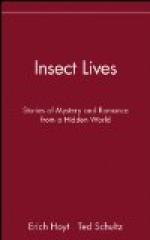[9] See Frontispiece, A.
Most remarkable, in many respects, of all aquatic larvae are the grubs of the Sand-midges (Simulium). These live entirely submerged and, having no special gills, carry out an exchange of gases through the general surface of the cuticle between the dissolved air in the water and the cavities of the air-tube system. The body is shaped like a flask swollen slightly at the hinder end and possesses a median pro-leg just behind the head, also another at the tail, which serves to attach the larva to a stone or to the leaf of an aquatic plant. The head has, in addition to feelers and jaws, a pair of processes with wonderful fringes which by their motion set up currents in the water, and bring food particles within reach of the mouth. A number of the larvae usually live in a community. Their power of spinning silken threads by which they can work their way back when accidentally dislodged from their resting-place, has been vividly described by Miall (1895).
Examples might be multiplied, but enough have been given to enforce the conclusion that the forms of insect-larvae are wondrously varied, and that frequently, within the limits of the same order or even family, modifications of type may be found which are suited to various modes of life adopted by different insects. A survey of the multitudes of insect larvae—grubs, caterpillars, maggots—living on land, on plants, underground, in the water; feeding on leaves, in stems, on roots, on carrion, on refuse; by hunting or by lurking after prey; as parasites or as scavengers, brings home to us most strongly the conclusion that each larva is fitted to some little niche in the vast temple of life, each is specially adapted to its part in the great drama of being.
CHAPTER VII
PUPAE AND THEIR MODIFICATIONS
The pupal stage is characteristic of the life-story of those insects whose larvae have wing-rudiments in the form of inpushed imaginal discs, and in all these insects there is, as we have seen, considerable divergence in form between larva and imago. In the pupa the wings and other characteristically adult structures are, for the first time, visible outwardly; it is the instar which marks the great crisis in transformation. The pupa rests, as a rule, in a quiescent condition, and during the early period of this stage the needful internal changes, the breaking down of many larval tissues, and their replacement by imaginal organs, go on. Both outwardly and inwardly therefore, the insect undergoes, at the pupal stage, a reconstruction necessitated by the differences in form and often in habit, between the larva and the winged adult; and the greater these differences, the more profound must be the changes that mark the pupal stage.




